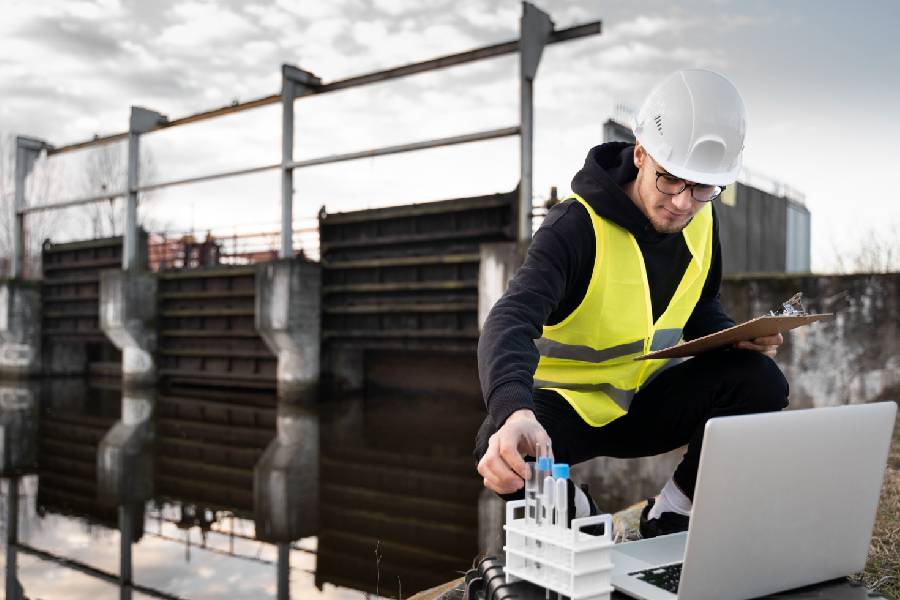The clean, safe drinking water from our taps originates in the forests, fields, and tributaries that comprise expansive watershed ecosystems. But how do watersheds affect water quality?
Our water quality experts investigate the complex ties between watersheds and water quality. Following the water’s path, we try to comprehend the factors connecting watershed health and the resulting water quality in rivers and lakes.
So, we will explore the pathways connecting upstream watersheds to the water delivered to our communities. Understanding these connections empowers our mission of learning how to improve water quality in watersheds.

How Do Watersheds Affect Water Quality?
Watersheds significantly influence the quality of water in rivers and lakes. Natural elements within watersheds, like soil and vegetation, act as filters, purifying water.
Rainfall and runoff within a watershed can carry sediments, chemicals, and contaminants into water bodies, impacting their quality. So, proper watershed management is essential to prevent pollution, maintain ecosystem health, and safeguard water resources.
Additionally, human-induced changes, like pollution and land development, can disrupt these processes, leading to potential water contamination. We believe that recognizing these interactions is vital for preserving the integrity of water resources.
Water Quality Fundamentals
Parameters defining water quality
- Physical parameters – These parameters encompass temperature, turbidity, clarity, and color. Temperature provides insight into the thermal conditions influencing aquatic life. Turbidity indicates the degree of suspended particles, and color offers visual cues about the water’s composition. These parameters collectively paint a vivid picture of the physical state of water bodies.
- Chemical parameters – This facet delves into an intricate analysis of elements, nutrients, and contaminants within water. By scrutinizing elements like heavy metals, nutrients like fertilizers, and potential pollutants, scientists gain a nuanced understanding of the chemical composition that defines water quality.
- Biological parameters – Assessing the health of aquatic ecosystems involves studying the living organisms present. These organisms, ranging from microscopic bacteria to larger aquatic species, are invaluable water quality indicators. Monitoring their presence, abundance, and vitality provides us with crucial insights into the biological integrity of water bodies.
Importance of maintaining high water quality standards
We recognize that ensuring high water quality standards is paramount for ecosystem health, safe drinking water, and sustainable community development.
By helping clients adhere to stringent water quality standards, our work safeguards human health, preserves biodiversity, and fosters responsible water resource management. This contributes to building more resilient and thriving communities.
The Hydrological Connection
How watersheds contribute to hydrological processes
Watersheds are crucial in hydrological processes, serving as the geographical area where precipitation, surface water, and groundwater interact. When rain falls or snow melts, water navigates through the watershed, eventually converging into streams and rivers. This is essential for sustaining water availability and regulating flow dynamics.
Impact on water quality throughout the cycle
The hydrological cycle within watersheds significantly influences water quality. As water traverses diverse landscapes, it encounters various elements that can either enhance or diminish its quality. Understanding this is crucial for pinpointing potential sources of contamination and implementing effective mitigation strategies.
Natural Purification Processes
Role of soil, vegetation, and geology in water filtration
Soil, vegetation, and geology are nature’s filtration systems within watersheds. Soil is a physical filter, trapping particles and impurities as water percolates.
Moreover, vegetation contributes to filtration through root systems and natural chemical processes, especially along riparian zones. The geological composition of the landscape also influences filtration capacity.
Ecological mechanisms for contaminant removal
Watersheds employ various ecological mechanisms to remove contaminants from water. Microbial activity in the soil helps break down pollutants, while plants absorb and accumulate certain substances.
Wetlands, often found in watersheds, serve as natural purifiers by capturing sediments and promoting biological processes that neutralize harmful substances. Understanding these natural processes guides sustainable practices for preserving water quality within watersheds.

Human Influences on Watershed Health
Impact of land development on watersheds
Urbanization and land development significantly alter the delicate balance of watershed ecosystems. As concrete jungles replace natural landscapes, the ability of watersheds to regulate water flow, filter pollutants, and support biodiversity diminishes.
Also, increased impervious surfaces lead to rapid runoff, worsening erosion, and sedimentation in water bodies. So, our engineers comprehend the intricate web of consequences arising from land development. We recognize the importance of sustainable practices to mitigate adverse impacts on watershed health.
Pollution sources and their effects on water quality
Anthropogenic activities introduce many pollutants into watersheds, directly threatening water quality. Agricultural runoff filled with fertilizers and pesticides, industrial discharges, and untreated urban stormwater all contribute to contamination.
Hence, understanding the sources and pathways of pollutants is crucial for engineers engaged in watershed management. It lays the groundwork for devising effective strategies to curb pollution and safeguard the integrity of downstream water bodies.
Engineering Solutions for Watershed Management
Innovations in sustainable land development
In response to the challenges posed by land development, our engineering solutions emphasize sustainable practices that harmonize human activities with watershed health. For example, green infrastructure, such as permeable pavements and green roofs, helps mimic natural processes, reducing runoff and enhancing water infiltration.
At Cypress Environment & Infrastructure, smart land-use planning is integral to preserving critical watershed areas and promoting eco-friendly development practices. That maintains the health of the vital ecosystems.
Technologies for pollution prevention and water quality enhancement
Our engineers are important in developing and implementing technologies that prevent pollution and enhance water quality within watersheds. Advanced stormwater management systems, including biofiltration and constructed wetlands, act as natural filters, removing pollutants before they reach water bodies.
Moreover, continuous monitoring technologies enable real-time data collection, aiding in prompt responses to emerging water quality issues.
The integration of innovative engineering solutions at Cypress ensures sustainable watershed management, balancing the needs of development with the imperative of environmental preservation.
Emerging Technologies in Watershed Monitoring
Role of advanced monitoring tools in assessing water quality
In the dynamic field of watershed management, cutting-edge technologies are essential in enhancing our understanding of water quality dynamics.
Advanced monitoring tools, such as remote sensing, sensor networks, and unmanned aerial vehicles (UAVs), empower scientists and engineers. They enable the collection of precise and real-time data across vast watershed areas.
These tools provide a comprehensive view of water quality parameters, including temperature, nutrient levels, and pollutant concentrations. Engineering students exploring watershed monitoring must grasp the significance of these technologies in gaining actionable insights for effective management strategies.
Technological advancements shaping the future of watershed management
The future of watershed management is intricately linked to technological advancements that promise more efficient, accurate, and sustainable monitoring solutions.
Artificial intelligence (AI) and machine learning algorithms are revolutionizing data analysis. They enable predictive modeling that helps our engineers identify potential water quality issues.
Also, sensor miniaturization and increased connectivity offer the potential for widespread deployment. This creates dense monitoring networks for detailed and continuous data collection.
As engineers delve into the complexities of watershed monitoring, staying abreast of these technological trends is essential. This is crucial for steering the field toward more informed and proactive management practices.

Conclusion
Now that you learned how do watersheds affect water quality, it will allow you to appreciate the engineering work that goes into protecting water quality in our development process. We hope this article has provided insight into how profoundly watersheds affect water quality and clarified the importance of implementing sustainable practices to safeguard these critical water sources.
Though complex, recognizing that healthy watersheds equal healthy water empowers our mission. We aim to protect water quality, sustaining communities now and for future generations. By taking a holistic watershed approach, we can ensure clean, safe water flowing from source to tap.
